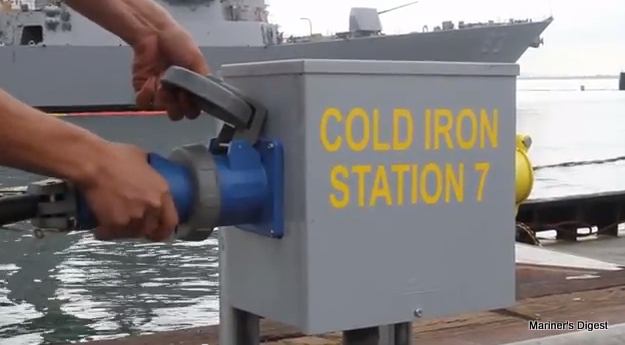Cold Ironing - The practise of providing power to a ship from shore, when she is in port, to enable the ship to shut down the diesel grunting auxiliary generators.
 |
| Cold Ironing - Alternative Shore Power |
The benefits are reduced PM and CO2 emissions in port area, thus ensuring a cleaner and greener environment around the harbor.
The technique of
providing shore power to ship when in port is rather quite old, of the time of
coal fired ships. The coal fired ships when entered port, would let their
coal fire die out and provide power to ship from shore connection. In this way,
the Iron engines were available in cold state, before next sailing. From here, came
the term cold ironing. Formally speaking, the technique is also named as
Alternative Marine Power (AMP) in many European ports.
Potential emission
taxes and fuel saving measures are prompting the port authorities and the ship
owners to adopt Cold Ironing method.
Particulate
emissions from ship remains a major concern for ports located in heart of
population and commerce. Excessive PM emissions from burning low cost marine
fuel degrades the air quality of the nearby areas. Also is the factor of the stringent
requirement by port authorities to switch over to ultra clean fuels of high
cost while in port areas.Though studies suggest that even the use of low
sulphur fuel doesn't match the cleanliness of shore power technology.
 |
| Cold Ironing |
Cruise ship
operators don't want their passenger to breathe the fumes of HFO while in port.
Given is the added advantage of reduced noise and vibration giving an added
serenity to the high end passengers.
The effectiveness
of the system in curbing pollution is much answered if the power supply is from
a hydroelectric utility rather than from a thermal power plant. It is well
understood that by using a thermal power plant the emission is merely
transferred from a port terminal to the thermal station.
The retrofit onboard a ship to recieve the shore terminal
for it's entire port power requirement includes a transformer that steps down
6,600-volt shoreside power to the ship specific volt power; room-size
enclosures that house the receptacles where shore-power cables are connected to
the vessels; and cabling that run from the receptacles through the transformer
and into the vessel’s electrical control panel.
Recreational
vessel have been using this technology for quite a some time in past but the
use of shore power for merchant vessel is a new entrant in shipping industry.
The question is:
If recreational vessel have been using this, then why it is new for merchant
vessels?
The answer would
be quite a complex one. But broadly speaking it is the economic constraints to
set up a system of huge power demand at a promising and viable cost.However,
technological advancements and environmental pressure has called upon to review
the method.
 |
| Cold Ironing Technique |
An important point to be considered is the varying demand
and supply ratio of power in port depending on the number of ship in the port
at any time. Let's say, The amount of power necessary to meet the
demands of a single ship is fifteen megawatts (MW). If the port can
accommodate four ships the capacity needs to be at least sixty MW. But because
the port will not have four ships in port at some times only a portion of the
needed capacity is used. Regardless of use the port still must incur the
expense of a sixty megawatt transformer substation on site and the feeder line
from the utility.
Another difficulty encountered is that there are
different voltage and frequency specifications for vessels built and operated
in different parts of the world. Most ships operate on low voltage of 440V
power, while large container and cruise ships operate on higher voltages of 6.6
to 11KV, and frequency requirements can vary from 50 or 60Hz. One
approach to solve this has been to use portable current convertor devices at
dockside, called Dual Frequency Multi Voltage, which can overcome the
compatibility problem. Perhaps, as the technology matures and becomes more
prevalent, standardization of power specifications will occur.
Ships could expect a payback time of three years and
ports four years if they invested in the technology.
In spite of many technological as well as economic
constraint shore power has been taken up by many North American ports including
Seattle, Vancouver, Los Angeles, San Diego, San Francisco, Oakland, and
Halifax.
However, U.S. is not the only nation to voice dissent
over the value of shore power.European countries too have
commissioned the project for cold ironing technique for some of their
ports. The British Society of Maritime Industries hosted a seminar that
discussed the viability of shore power.
A note for use of renewable energy for shore
power can not be left with.Though, the economic constraints of cold ironing
puts a question mark on use of it, we are actually left with fewer options to
adopt. The use of solar photovoltaic cell or windmills demands a huge
installaton area, which is hardly available near to ports. Also the use of
battery banks of such a capacity, requires a bank of a size of building.
Watch this video for a better insight on Cold Ironing:
Though offshore wind farm installation, would prove to be
a major advantage for ports setting up plans of using costly utility power for
cold ironing. Offshore windfarm installation would grant freedom to ports in
terms of power tariff, and would also prove as an even greener initiative. To read more about Offshore Windfarm, read this earlier post : Offshore Windfarms
Left with any queries, drop in your questions in comment section.
Related articles : Offshore Windfarms
Excited to hear positive feedback from readers. Many thanks for liking the write-up.
ReplyDeletewow really superb! Thanks
ReplyDeleteRetro fit emission control device for diesel generators
Nice article
ReplyDeleteBreaker Bar